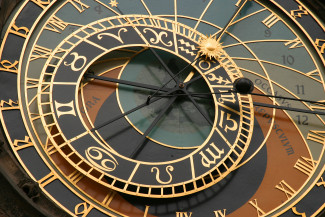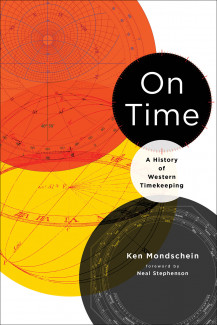
Johns Hopkins UniversityEst. 1876
America’s First Research University
Now Browsing:
On Time: A History of Western Timekeeping

It was fencing that led me to my interest in the history and philosophy of timekeeping.
Forget what you think you know about fencing—what you’ve seen in TV shows and movies and such. The reality is both less visually exciting and intellectually more engaging.
In a choreographed stage combat, I want to show a third party—the audience—the impression of a sword fight to further the plot, while at the same time not actually striking the other person, who is, in the end, my partner in presenting a work of theater. The action must be legible: Your turn, my turn, your turn, my turn. In actual fencing bout, however, I’m faced with an uncooperative opponent who is trying to defeat me by striking me with their weapon. Showing an audience what is happening is not important at all. The game is thus one of preempting, countering, and interrupting one another’s actions. In other words, I must time my actions to those of my adversary: Parry before the attack arrives, and you’re hit; parry after it arrives, you’re also hit.
To describe the timing of actions in fencing, we use a sophisticated vocabulary that is ultimately derived from Aristotle’s definition of time as “the number of motion with respect to the before and after.” Instead of an absolute, abstract, objectively defined unit of time such as the second, in fencing, all “time” depends on the relative measurement of moving things. One tempo, or one unit of time, is thus one integral fencing motion such as an extension or a lunge. This conception dates back to the Middle Ages, and is one of the very few realms in which we still use “medieval” conceptions of the natural world.
Ironically, the Middle Ages were also the origins of modern timekeeping. The mechanical clock was invented in the fourteenth century, allowing medieval people to measure time against a model of the moving thing they thought the most absolute and authoritative—the daily revolution of the stars in the sky. Soon, tower clocks were reigning over medieval cities, tying the cycles of daily life to the heavens.

On the smaller scale, though, pre-modern people did not have precise or accurate timepieces: They could still only measure one relative duration against another. Even Galileo, in the sixteenth century, had to confirm his hypothesis on the uniform acceleration of falling objects by comparing the volumes of water let out from a water-clock he used as a timing device.
By the late eighteenth century, however, the stopwatch had made the measurement of small periods of time possible, while the chronometer seemed to be the very mirror of Newton’s “absolute time,” unchanging and equally flowing no matter where it was. Industrialization and imperialism spread these concepts through the whole world and all levels of society, and, even though Einstein’s relativity upset them somewhat, they are still with us today.
Considering my obsession not only with fencing, but with the histories of science and philosophy, it was natural I should gravitate towards the subject of timekeeping in medieval Paris in Dan Smail’s graduate seminar at Fordham. Thanks to the aid of a Fulbright grant to France and the mentorship of my advisor, Richard Gyug, I completed my dissertation on timekeeping in medieval Paris in 2010. The following year, I met Greg Britton, then the publisher at the Getty, when that institution asked me to write a short work on their copy of Fiore dei Liberi’s fifteenth-century fencing treatise (published as The Knightly Art of Battle). When he moved to Johns Hopkins and I proposed writing a book on the history of timekeeping for the University Press, he gave me his enthusiastic support.
There is already a vast body of scholarship on this subject, but with On Time, I wanted to do something new: Not just conduct original research into how medieval people’s conceptions of time mirrored their lived experience, but to look at how intellectual and technological developments affected lived experience from the ancient world to the present—and vice versa.
Order On Time: A History of Western Timekeeping – published on September 15, 2020 – at the following link: https://jhupbooks.press.jhu.edu/title/time
Ken Mondschein is a historian and a full-time contingent faculty member who teaches at the University of Massachusetts–Mount Ida, Boston University, and Anna Maria College. He is the author of On Time: A History of Western Timekeeping, editor and translator of Fencing: A Renaissance Treatise, and the cotranslator of Flowers of Battle, Volume III: Florius de Arte Luctandi.

Forget what you think you know about fencing—what you’ve seen in TV shows and movies and such. The reality is both less visually exciting and intellectually more engaging.
In a choreographed stage combat, I want to show a third party—the audience—the impression of a sword fight to further the plot, while at the same time not actually striking the other person, who is, in the end, my partner in presenting a work of theater. The action must be legible: Your turn, my turn, your turn, my turn. In actual fencing bout, however, I’m faced with an uncooperative opponent who is trying to defeat me by striking me with their weapon. Showing an audience what is happening is not important at all. The game is thus one of preempting, countering, and interrupting one another’s actions. In other words, I must time my actions to those of my adversary: Parry before the attack arrives, and you’re hit; parry after it arrives, you’re also hit.
To describe the timing of actions in fencing, we use a sophisticated vocabulary that is ultimately derived from Aristotle’s definition of time as “the number of motion with respect to the before and after.” Instead of an absolute, abstract, objectively defined unit of time such as the second, in fencing, all “time” depends on the relative measurement of moving things. One tempo, or one unit of time, is thus one integral fencing motion such as an extension or a lunge. This conception dates back to the Middle Ages, and is one of the very few realms in which we still use “medieval” conceptions of the natural world.
Ironically, the Middle Ages were also the origins of modern timekeeping. The mechanical clock was invented in the fourteenth century, allowing medieval people to measure time against a model of the moving thing they thought the most absolute and authoritative—the daily revolution of the stars in the sky. Soon, tower clocks were reigning over medieval cities, tying the cycles of daily life to the heavens.

On the smaller scale, though, pre-modern people did not have precise or accurate timepieces: They could still only measure one relative duration against another. Even Galileo, in the sixteenth century, had to confirm his hypothesis on the uniform acceleration of falling objects by comparing the volumes of water let out from a water-clock he used as a timing device.
By the late eighteenth century, however, the stopwatch had made the measurement of small periods of time possible, while the chronometer seemed to be the very mirror of Newton’s “absolute time,” unchanging and equally flowing no matter where it was. Industrialization and imperialism spread these concepts through the whole world and all levels of society, and, even though Einstein’s relativity upset them somewhat, they are still with us today.
Considering my obsession not only with fencing, but with the histories of science and philosophy, it was natural I should gravitate towards the subject of timekeeping in medieval Paris in Dan Smail’s graduate seminar at Fordham. Thanks to the aid of a Fulbright grant to France and the mentorship of my advisor, Richard Gyug, I completed my dissertation on timekeeping in medieval Paris in 2010. The following year, I met Greg Britton, then the publisher at the Getty, when that institution asked me to write a short work on their copy of Fiore dei Liberi’s fifteenth-century fencing treatise (published as The Knightly Art of Battle). When he moved to Johns Hopkins and I proposed writing a book on the history of timekeeping for the University Press, he gave me his enthusiastic support.
There is already a vast body of scholarship on this subject, but with On Time, I wanted to do something new: Not just conduct original research into how medieval people’s conceptions of time mirrored their lived experience, but to look at how intellectual and technological developments affected lived experience from the ancient world to the present—and vice versa.
Order On Time: A History of Western Timekeeping – published on September 15, 2020 – at the following link: https://jhupbooks.press.jhu.edu/title/time
Ken Mondschein is a historian and a full-time contingent faculty member who teaches at the University of Massachusetts–Mount Ida, Boston University, and Anna Maria College. He is the author of On Time: A History of Western Timekeeping, editor and translator of Fencing: A Renaissance Treatise, and the cotranslator of Flowers of Battle, Volume III: Florius de Arte Luctandi.

Login to View & Leave Comments
Login to View & Leave Comments


